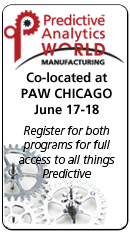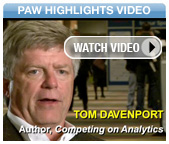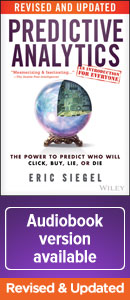Conference Day 1: Tuesday, June 17, 2014 |
Registration & Networking Breakfast
[ Top of this page ] [ Agenda overview ]
Conference Chair Welcome Remarks
Speaker: Eric Siegel, Founding Chair, Predictive Analytics World
8:50-9:10am • Room: S104AB
Sponsor Presentation
From Quality Control and Reacting to Predictive Quality Control and Pre-Acting
Forward looking manufacturers have long recognized the value of data and statistical analysis techniques. In data-driven organizations, conversations about quality and best practices have moved from opinions and ad-hoc trouble-shooting to insights rooted in compelling results derived from empirical data. However, the exponential growth in the available data volume and velocity requires new methods, but also opens up new opportunities for using modern predictive modeling techniques to drive quality and efficiency. This presentation will review the basic difference between statistical analyses and modern predictive modeling techniques. The discussion will then explore typical use cases and approaches how to implement process monitoring and quality control for high-dimensional data, considerations for predictive quality control, and technologies and system requirements to enable a sustainable system that will generate repeatable ROI.
Keynote
The Prediction Effect, the Data Effect, and the Persuasion Effect
What are the underlying principles that make predictive analytics effective? Why is data predictive, why is imperfect prediction valuable, and what type of prediction succeeds to persuade? You have heard of the butterfly, Doppler, and placebo effects. In this session, PAW founder Eric Siegel covers the Prediction, Data, and Persuasion Effects. Each of these Effects encompasses the fun part of science and technology: an intuitive hook that reveals how it works and why it succeeds.
Attendee's receive a free copy of the related book by Eric Siegel, Predictive Analytics: The Power to Predict Who Will Click, Buy, Lie, or Die.
Speaker: Eric Siegel, Founding Chair, Predictive Analytics World
Exhibits & Morning Coffee Break
[ Top of this page ] [ Agenda overview ]
 Track 1: Large-Scale Continuous Learning
Track 1: Large-Scale Continuous Learning Case Study: eBay
Data Science empowering personalization
Commerce is at an inflection point where customers expect better and easier experiences both online and offline. They expect individualized experiences, while at the same time demand that their privacy is safeguarded. This presentation describes a predictive solution that enables real-time personalization at scale. Data Science is used to leverage eBay's powerful infrastructure, services and massive amounts of commerce data, while protecting the privacy of eBay's customers.
Speaker: Ashok Ramani, Product Lead, Big Data, eBay Inc.
10:30-11:15am • Room: S104AB
 Track 2: Analytics Techniques
Track 2: Analytics TechniquesCase Study: Hewlett-Packard
Customer Analytics in Action: Alternative Approaches to Customer Targeting for Marketing Campaign
Generating tangible level of ROI is a real challenge for any marketing campaign for organizations across industries. A major task for an effective marketing campaign is to identify the right target customers based on their potential to respond. To identity the probable responders, multiple predictive models can be used based on the business situation and data availability. In this session we will explore, how this same business problem can be solved through various analytical techniques.
[ Top of this page ] [ Agenda overview ]
 Track 1: Store Outlet Analytics
Track 1: Store Outlet Analytics
Case Study: Redbox
Improving Store-Level Test & Control Methodology at Redbox
This case study covers a deployed test and control methodology implemented at the site level (meaning you make an operational or marketing change to some stores, but not others), as well as how to evaluate false readings from such a test and calculate the true impact. Initial work has suggested that false readings are significant problem when using test and control on stores, vs. a pure marketing application where you can choose a large random sample of customers.
11:20am-12:05pm • Room: S104AB
 Track 2: Market Mix Modeling
Track 2: Market Mix Modeling
A White-box Approach to Marketing Mix Analytics
As marketing channels proliferate, Decision Sciences teams must continually refine their marketing mix analytics to evaluate the effectiveness of new channels and provide actionable recommendations for budget optimization to their marketing counterparts. As the complexity of marketing mix analytics increase, it is important for all stakeholders to speak a common language that bridges the gap between business questions and analytics solutions.
This presentation will describe the evolution of marketing mix analytics at a division of United Healthcare and how the Marketing, Marketing Finance and Data Analytics teams work together to maximize the ROI of their marketing budget.
Mike Feldner, Geography Head, Mu Sigma
[ Top of this page ] [ Agenda overview ]
Lunch in Exhibit Hall
Lunch and Learn
Growth & Foresight Analytics
In a world where the consumer, the market and the economy are constantly changing, you need effective tools to navigate these changes. Dr. Eugene Roytburg, Managing Partner of 4i inc., will present the latest in how growth and foresight analytics can help companies uncover future growth opportunities, size future demand and develop growth strategies to succeed in tomorrow's marketplace.
Special Plenary Session
The Peril of Vast Search (and How Target Shuffling Can Save Science)
It's always possible to get lucky (or unlucky). When you mine data and find something, is it real, or chance? The central question in statistics is "How likely could this result have occurred by chance?" Ancient geniuses devised formulas to answer this question for multiple special-case scenarios. Yet, their calculus only applies to quaint, handmade analyses, where only a few hypotheses are considered. However, modern predictive analytic algorithms are hypothesis-generating machines, capable of testing millions of "ideas". The best result stumbled upon in its vast search has a much greater chance of being spurious. Such overfit is particularly dangerous, as it leads one to rely on a model molded to the data noise as well as signal, which usually is worse on new data than no model at all. The problem is so widespread that it is the chief reason for a crisis in experimental science, where most journal results have been discovered to resist replication; that is, to be wrong!
The good news is an antidote exists! Dr. Elder will explain the simple breakthrough solution -- still rarely employed, though newly being re-discovered in leading fields. John will illustrate how to use the resampling method he calls "Target Shuffling" in multiple learning scenarios, from model fitting to data exploration, showing how it calibrates results so they are reliable - essentially providing an honest "placebo effect" against which to test a new treatment (finding).
Bottom line: Honest Data Science can save Experimental Science!
[ Top of this page ] [ Agenda overview ]
 2:15-2:30pm • Room: S104AB
2:15-2:30pm • Room: S104AB
Gold Sponsor Presentation
The New Age of Analytics
The Analytics industry is at a very interesting phase in its maturity. Organizations are becoming more familiar with using a variety of data sets, and presenting insights and applying predictive analytics to various degrees. At the same time, Analytics is becoming more machine-driven with the help of advanced computing power and use of machine learning, artificial intelligence, NLP, etc. With the relevance of the machine in the Analytics space, computer science is also becoming very dominant, along with statistics and mathematics, and data management. Therefore, the kinds of resources (data scientists) that are being sought after today must be a combination of statisticians, data analysts, computer science professionals and BI resources. Blueocean will discuss the convergence of Analytics with the computer science / software industry, and how this synergy can deliver more meaningful outcomes for organizations.
2:40-3:00pm • Room: S105A
 Track 1: Sales Forecasting
Track 1: Sales Forecasting Case Study: United Stationers
Accurate Forecasts Using Predictive Analytics
Accurate sales forecasts are critical for creating company budgets and aligning resources effectively. Today, companies have moved beyond salesforce predictions to include predictive analytics like Time Series Forecasting & Monte Carlo Analysis. Attend and hear how United Stationers (NASDAQ: USTR), a Fortune 500 wholesale distribution company, uses predictive analytics to forecast sales for 3 of its divisions. This method of forecasting has helped United Stationers improve the overall accuracy of its forecasts.
2:40-3:00pm • Room: S104AB
 Track 2: Political Campaign Analytics
Track 2: Political Campaign AnalyticsCase Study: A Congressional Election Campaign
Data Mining Campaign Data of a Congressional Race Against an Incumbent of the Same Party
The 2012 Presidential election showed the true power of predictive analytics at scale. The powerful results of the analyses from the analytics efforts made on the campaign will forever reshape the role of quantitative methods when measuring efficacy in political campaigns. As with other analytics projects, refinement will have a multitude of facets. While many of these in future campaigns will likely revolve around data issues -- such as incorporating and inferencing from newer sources -- an area of particular interest will be modeling the effects of infighting within a party while measuring reach and forecasting a congressional election outcome.
[ Top of this page ] [ Agenda overview ]
3:05-3:25pm • Room: S105A
 Track 1: Alternative Data Sources
Track 1: Alternative Data SourcesCase Studies: CFPB, Capital One, Citibank, Bank of America
Open Your Eyes and Ears: Leveraging Predictive Analytics and Alternative Data Sources to Improve the Customer Experience
Utilizing customer feedback to drive decisions is nothing new for businesses, but the locations and forms of conversations have shifted drastically in recent years. Because of this, companies now have greater transparency into customer relationships at the same time that individual consumers have a more visible platform to share their positive and negative experiences with individuals worldwide. This session examines new capabilities and platforms, such as social media and the CFPB consumer complaint database, that banks can use to simplify the evaluation of customer insights and determine necessary service changes to prevent loss of business.
Speaker: Steven Ramirez, CEO, Beyond the Arc, Inc.
3:05-3:25pm • Room: S104AB
 Track 2: Workforce Analytics - Retention
Track 2: Workforce Analytics - Retention Case Study: A Household-Name Financial Services Firm
A Data Science Approach to Reduce Call Center Attrition
Attend this session and examine how a major financial services firm's call center used data science to significantly reduce attrition by over 30%, yielding a multi-million dollar savings.
- Analytics managers will leave this session with a concrete understanding of the business value of talent optimization, showing how correlating "raw talent" to attrition can yield unprecedented results.
- Analytics practitioners will leave this session with a concrete understanding of the analytics approach and models used to reduce attrition.
Speaker: Pasha Roberts, Chief Scientist, Talent Analytics, Corp.
[ Top of this page ] [ Agenda overview ]
Exhibits & Afternoon Break
3:55-4:40pm • Room: S105A
 Track 1: Churn Modeling for Customer Retention
Track 1: Churn Modeling for Customer RetentionCase Study: Paychex Inc.
Combat Client Churn with Predictive Analytics
In economic conditions such as this, it's critical for businesses to have a stronghold on their client retention efforts. Historically, it has been shown that businesses that excel in this arena are often better positioned for long-term success and possess a competitive advantage. To optimize the value of retained customers it's essential to understand which clients are a fit for retention campaigns so that the loss of time and resources is minimized. In this session, we examine how Paychex leveraged two existing models, Paychex Attrition Model and a custom built Lifetime Value Model, to create a Retention Tracking program.
3:55-4:15pm • Room: S104AB
 Track 2: Social Media for Financial Trading
Track 2: Social Media for Financial TradingUsing Social Media Analytics in Trading Strategies
Social Media is already a large, but still rapidly growing, means of communication and efficient global interaction. Many of the conversations on Twitter discuss companies, stocks and market activity. In 2013, the SEC embraced social media and approved the use of Facebook and Twitter for company financial disclosures. Numerous attempts are made to mine social data for actionable trading insights. While social media and sentiment evaluation holds countless opportunities for investors, there are also risks. This session examines the lessons learned, risks, rewards, and latest trends. We describe a framework adopted by the NYSE and provide descriptive examples.
[ Top of this page ] [ Agenda overview ]
4:20-4:40pm • Room: S104AB
 Track 2: Retail Analytics
Track 2: Retail AnalyticsCase Study: Luxottica
Next-Best Activity Powered by Predictive Modeling
This session introduces the concept of next-best activity and illustrates how Luxottica Retail North America adopted a new generation of predictive models built to have a more active role in targeting and marketing to different customers. Attend and examine the full suite of models needed and some of the initial results in terms of predictions and performance.
4:45-5:30pm • Room: S105A
 Track 1: Insurance
Track 1: InsuranceCase Study: AIG
Predictive Analytics in Insurance
This case discusses the use of predictive analytics to evaluate professional service firms, make the right in-source/outsource decision, and develop strategies to improve the delivery of professional services. Attend and learn how savings were realized by the better matching professional service needs with professional service providers, and how the decision to in-source resulted in a measurable financial impact.
Francisco Javier Arceo, Sr. Quantitative Anayst - Science, AIG
4:45-5:30pm • Room: S104AB
 Track 2: Analytics Leadership
Track 2: Analytics LeadershipUsing Sports to Teach Analytics
As analytics practitioners, we often find ourselves in the role of teacher. As teachers, we sometimes struggle to meet the needs of our varied audiences. This presentation shares examples of how sports can be used as the universal context to teach concepts -- ranging from data warehousing to predictive analytics to information strategy -- to diverse audiences in both business and academia. Attend and learn what steps you should consider to become better teachers of analytics.
Networking Reception
[ Top of this page ] [ Agenda overview ]
Conference Day 2: Wednesday, June 18, 2014 |
Registration & Networking Breakfast
Conference Chair Welcome
Diamond Sponsor Presentation
The Rise of Operational Predictive Systems
We are in the midst of an analytics renaissance partly because of a computer science discipline called Machine Learning. In simple terms, machine learning is the study of computing systems that improve their performance or capabilities with experience. Machine learning is powering a resurgence of optimism and excitement in the research and practitioner community. However, the impact of ML goes well beyond research. Machine learning, today, is likely the most important core computing technology in the IT industry. Using machine learning over historical data one can produce what is arguably the most valuable data product, a predictive model. Over the next decade predictive analytics will become even more ubiquitous, made possible by an ever-growing network of connected devices, incredible computing capacity from the cloud, and intelligence from machine learning.
In this talk the co-presenters will present a brief overview of machine learning, explain how abundant computing together with inexpensive storage in the cloud and distributed learning have enabled this revolution, and illustrate using concrete applications the advances made in both industry and research applications. This talk will conclude with a look ahead on the role of cloud machine learning and intelligent cloud services.
Zubin Dowlaty, Head of Innovation and Development, Mu Sigma
Persuasion Modeling (aka Uplift Modeling)
Keynote
Case Study: Obama for America
Pinpointing the Persuadables: Convincing the Right Customers and the Right Voters
Marketing, political campaigning, and healthcare have one major thing in common: millions of per-person treatment decisions must be selected in order to drive positive outcomes. Prior to President Obama's reelection campaign, standard practices for persuading votersthat is, changing their mindswere unscientific and driven by long-standing assumptions and hunches. This mirrors outreach efforts by other companies and organizations, which know that a certain percentage of their marketing efforts will inevitably be wasted on people who are not going to be receptive to it. Daniel Porter of BlueLabs, who served as the Director of Statistical Modeling for the Obama Campaign, will discuss his experience using the results from a large-scale randomized, controlled experiment to target persuadable voters for the Obama Campaign, as well as ways these cutting edge statistical modeling techniques can be applied to influencing behavior in realms ranging from health outcomes to customer retention.
[ Top of this page ] [ Agenda overview ]
Exhibits & Morning Coffee Break
 Track 1: Driver Safety
Track 1: Driver Safety
Beyond Telematics: Using Data to Predict the Future
Vehicle Telematics is a method of monitoring the location, movements, status and behavior of a vehicle or fleet of vehicles. But, in today's world, fleet managers need to know much more than "there was a hard brake at 3:00 PM on Main Street". Video-based behavior data provides the inputs they need to predict collisions and determine which drivers need to be coached. By knowing what actually caused that hard brake, fleet managers can focus their efforts on improving behavior to reduce collisions and operational costs.
 Track 1: Large-Scale Sensor Processing
Track 1: Large-Scale Sensor Processing
Case Study: Smart City San Diego
Sensor Streams: Big Data Predictive Analytics
Sensor networks are ubiquitous and virtually wrap our planet into a Digital Earth. This evolutionary, planet-wide infrastructure generates an infinite amount of data that can potentially bring clarity and action to a range of societal challenges from resource depletion to disaster response and recovery, and from population explosion to food and water insecurity. This is a Big Data challenge: harnessing real-time, streaming sensor data from heterogeneous sensor networks, while enabling advanced processing, modeling, optimization, real-time forecasting, and analytics.
10:30-11:15am • Room: S104AB
 Track 2: Data Cleansing
Track 2: Data Cleansing
Data Preparation from the Trenches: 4 Approaches to Deriving Attributes
The data preparation stage of predictive modeling is often viewed and the most time-consuming, with experts describing the time expended in this stage ranging from 50% to even 90%. One of the problems modelers encounter with data preparation is that the needs and solutions for data cleaning and creation of new variables (features) changes with each project or sometimes even within a single project because there is no theory that tells us what to do. This session focuses on four key principles used in the creation of derived variables. Examples from actual modeling projects will illustrate the principles.
[ Top of this page ] [ Agenda overview ]
 Track 1: Ensemble Methods
Track 1: Ensemble Methods
Using Machine Learning to Improve Student Success
Western Governors University tapped their big data and leveraged a completely automated solution for advanced machine learning to generate daily predictions of success for over 45,000 students. They harnessed the cost effective compute-power of the cloud to build over 240 unique predictive ensembles to give staff actionable predictions for every student.
Western Governors University (WGU) is a not-for-profit, online competency-based university serving more than 45,000 students. Students receive academic credit by passing independent assessments - there are synchronous classes or homework. Students are guided through each academic term by faculty Mentors. Since there are no interim grades in this academic model it can be difficult to determine which students will successfully pass their assessments in a six month academic term. WGU deployed a cloud-based, ensemble method machine learning to predict which students would and would not successfully complete the term. The Predictions enabled standardized academic interventions and the basis to track what types of interventions work for students with specific risk profiles. Attendees will learn how data was selected, formatted for machine learning, ensemble models were automatically generated, and data were passed back to CRM. In addition, attendees will see the effect of faculty intervention on at-risk-students.
11:20am-12:05pm • Room: S104AB
 Track 2: Uplift Modeling
Track 2: Uplift Modeling
Case Study: Subaru of America
Uplift Modeling and Beyond
How do you drive business results and incremental value from your marketing investments? What good is your complex, real-time predictive model for banner advertising if you cannot determine if the offer or ad exposure actually nudged the user to convert to the action that you wanted them to take? Any model can find internet user cookies that are likely to convert, but uplift is required if you want to identify users who need that extra push across the finish line. Partnering with Rocket Fuel, Carmichael Lynch Analytics team brought uplift to Subaru of America with some very measurable positive results.
Peter Amstutz, Analytic Strategist, Carmichael Lynch
[ Top of this page ] [ Agenda overview ]
Lunch in Exhibit Hall
Keynote
Big Data and Numbersense: The Secret Ingredient to Great Analytics
One key ingredient of a great analytics team is numbersense, that noise in your head when you see bad data or bad analysis. This quality is distinct from numeracy or "common sense." I will explain the key ideas behind numbersense, drawing on cases studies involving its use. Along the way, I will discuss the role of theory, the value of raw data, the scientific method, data versus instincts, and the art of criticizing statistical studies. The need for numbersense is magnified in the age of Big Data. I will introduce the OCCAM framework for thinking about Big Data, and suggest where statistical thinking helps navigate the challenges of new datasets. As the world gets swamped with data, hiring the right analysts with numbersense is more important than ever before.
Lightning Round








![]()

[ Top of this page ] [ Agenda overview ]
Expert Panel
Necessary Skills of the Quant: Finance, Fraud, and Marketing
What makes a quant a true rockstar? What kind of soft skills, what kind of tech skills and background, and what portfolo of experience? With the organizational process behind predictive analytics - across business applications such as fraud and marketing - something of an art form, the requisite skills of key analytics staff are multidemensional and often hard to nail down. This expert panel will grab a hammer and start defining exactly what's needed in this very particular workforce.
Kaiser Fung, VP, Business Intelligence, Vimeo; Professor, NYU and Author, Numbers Rule Your World
Mike Feldner, Geography Head, Mu Sigma
Exhibits & Afternoon Break
 Track 1: Public Health / Food Safety
Track 1: Public Health / Food Safety
Case Study: Chicago Department of Public Health
Transforming Food Inspections Using Predictive Analytics
The Chicago Department of Public Health is innovating to lessen the burden on taxpayers and improve public health by engaging predictive analytics in their food safety protection program. Using the frame of analytics, the department partnered with development and coding organizations to build a database. Data (including building environments, 311 calls, previous sanitation code violations, social media, previous building code violations, sourcing of food, lack of alley lights, population density, near-by construction, complaint history of other establishments owned by the same person/group, and many other variables) are fed into a predictive model that outputs risk scores for each establishment allowing targeting of inspectors.
Speaker: Jay Bhatt, Managing Deputy Commissioner, Chicago Department of Public Health
3:30-4:15pm • Room: S104AB
Track 2: Media Placement:
Beyond Market Mix Modeling
Case Study: Axis Bank & Kotak Mahindra Bank (India)
Convergence Modeling across Paid, Owned and Earned Media to Measure Business Effectiveness
With media ROI in question, marketers must measure advertising impact on tangible business revenue, rather than brand alone. Marketing Mix Models do not suffice because not all media affect revenue directly, nor are media vehicles independent. We built POEM", Paid-Owned-Earned Model, using Structural Equation Modeling to capture inter-relationships across media platforms. POEM quantifies both direct and indirect influencers on measured KPIs, and even incorporates softer human" attributes, like consumer experience, using latent variables. POEM caused a paradigm shift in media investments for two Indian banking clients, Axis Bank and Kotak Mahindra Bank, and serves as their principal marketing decision-support system.
Aarti Bharadwaj, Vice President, Analytics Centre of Excellence, Starcom Mediavest Group, India
[ Top of this page ] [ Agenda overview ]
 Track 1: Software Engineering Optimization
Track 1: Software Engineering Optimization
Case Study: IBM
Optimizing Resource Allocation to Increase the Efficiency of Software Development
Multiple attempts have been made to measure software development productivity, from lines of code to function points; however most of them proved to be unsuccessful. The decisions made on cost-per-employee alone didn't lead to desired outcomes, as they didn't consider return on investments, such as quality and quantity. And as the economy became more global, the need for consistent and automated productivity measurement was only growing. This case examines how we developed composite productivity indicators based on the entire development ecosystem, leveraging data-driven methodology to measure and optimize resource allocation across development tasks and globally distributed teams, while enabling sharing of best practices.
Peter Bradford, Vice President, Certification, Product Development and Management Association Worldwide, Product Management Profession Leader, IBM
4:20-5:05pm • Room: S104AB
 Track 2:Consumer Cognitive Modeling
Track 2:Consumer Cognitive Modeling
Media and Murder: By the Numbers
This session dives into predictive technology for marketers and will take you from genes to memes as we discuss how mathematical algorithms that emulate human cognition can interpolate between ideas to derive meaning and intent. Hear evidence as to how this type of "organic algorithm" can glean insight and be predictive of a consumer's mindset. Using a recent study to illustrate, we'll discuss how the same approach using predictive technology can be applicable to map behaviors and intent for consumers and serial killers.
[ Top of this page ] [ Agenda overview ]






































